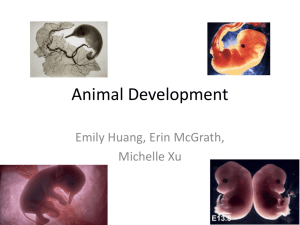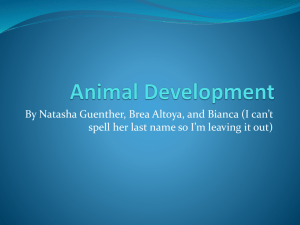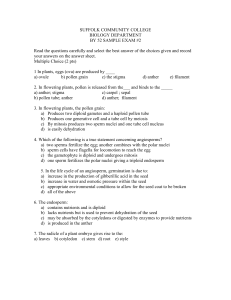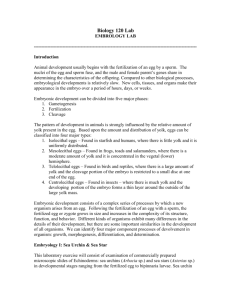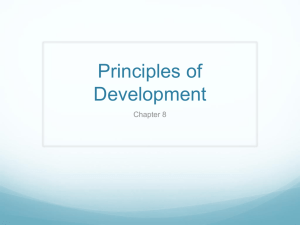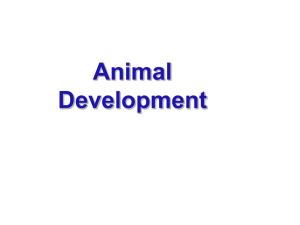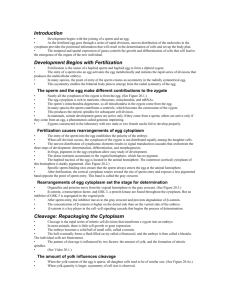AP Biology Notes Outline Animal Development Chapter 47
advertisement
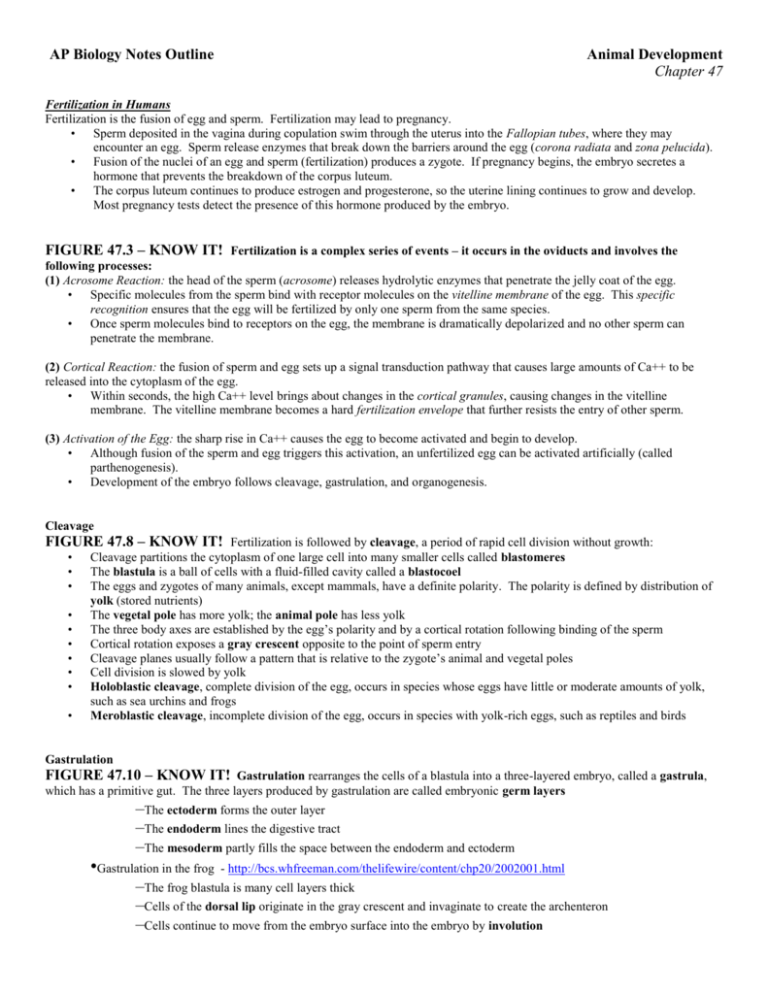
AP Biology Notes Outline Animal Development Chapter 47 Fertilization in Humans Fertilization is the fusion of egg and sperm. Fertilization may lead to pregnancy. • Sperm deposited in the vagina during copulation swim through the uterus into the Fallopian tubes, where they may encounter an egg. Sperm release enzymes that break down the barriers around the egg (corona radiata and zona pelucida). • Fusion of the nuclei of an egg and sperm (fertilization) produces a zygote. If pregnancy begins, the embryo secretes a hormone that prevents the breakdown of the corpus luteum. • The corpus luteum continues to produce estrogen and progesterone, so the uterine lining continues to grow and develop. Most pregnancy tests detect the presence of this hormone produced by the embryo. FIGURE 47.3 – KNOW IT! Fertilization is a complex series of events – it occurs in the oviducts and involves the following processes: (1) Acrosome Reaction: the head of the sperm (acrosome) releases hydrolytic enzymes that penetrate the jelly coat of the egg. • Specific molecules from the sperm bind with receptor molecules on the vitelline membrane of the egg. This specific recognition ensures that the egg will be fertilized by only one sperm from the same species. • Once sperm molecules bind to receptors on the egg, the membrane is dramatically depolarized and no other sperm can penetrate the membrane. (2) Cortical Reaction: the fusion of sperm and egg sets up a signal transduction pathway that causes large amounts of Ca++ to be released into the cytoplasm of the egg. • Within seconds, the high Ca++ level brings about changes in the cortical granules, causing changes in the vitelline membrane. The vitelline membrane becomes a hard fertilization envelope that further resists the entry of other sperm. (3) Activation of the Egg: the sharp rise in Ca++ causes the egg to become activated and begin to develop. • Although fusion of the sperm and egg triggers this activation, an unfertilized egg can be activated artificially (called parthenogenesis). • Development of the embryo follows cleavage, gastrulation, and organogenesis. Cleavage FIGURE 47.8 – KNOW IT! Fertilization is followed by cleavage, a period of rapid cell division without growth: • • • • • • • • • • Cleavage partitions the cytoplasm of one large cell into many smaller cells called blastomeres The blastula is a ball of cells with a fluid-filled cavity called a blastocoel The eggs and zygotes of many animals, except mammals, have a definite polarity. The polarity is defined by distribution of yolk (stored nutrients) The vegetal pole has more yolk; the animal pole has less yolk The three body axes are established by the egg’s polarity and by a cortical rotation following binding of the sperm Cortical rotation exposes a gray crescent opposite to the point of sperm entry Cleavage planes usually follow a pattern that is relative to the zygote’s animal and vegetal poles Cell division is slowed by yolk Holoblastic cleavage, complete division of the egg, occurs in species whose eggs have little or moderate amounts of yolk, such as sea urchins and frogs Meroblastic cleavage, incomplete division of the egg, occurs in species with yolk-rich eggs, such as reptiles and birds Gastrulation FIGURE 47.10 – KNOW IT! Gastrulation rearranges the cells of a blastula into a three-layered embryo, called a gastrula, which has a primitive gut. The three layers produced by gastrulation are called embryonic germ layers –The ectoderm forms the outer layer –The endoderm lines the digestive tract –The mesoderm partly fills the space between the endoderm and ectoderm •Gastrulation in the frog - http://bcs.whfreeman.com/thelifewire/content/chp20/2002001.html –The frog blastula is many cell layers thick –Cells of the dorsal lip originate in the gray crescent and invaginate to create the archenteron –Cells continue to move from the embryo surface into the embryo by involution AP Biology Notes Outline Animal Development Chapter 47 – These cells become the endoderm and mesoderm –The blastopore encircles a yolk plug when gastrulation is completed –The surface of the embryo is now ectoderm, the innermost layer is endoderm, and the middle layer is mesoderm Organogenesis FIGURE 47.12 – KNOW IT! During organogenesis, various regions of the germ layers develop into rudimentary organs •The frog is used as a model for organogenesis •Early in vertebrate organogenesis, the notochord forms from mesoderm, and the neural plate forms from ectoderm •The neural plate soon curves inward, forming the neural tube •The neural tube will become the central nervous system (brain and spinal cord) •Neural crest cells develop along the neural tube of vertebrates and form various parts of the embryo (nerves, parts of teeth, skull bones, and so on) •Mesoderm lateral to the notochord forms blocks called somites •Lateral to the somites, the mesoderm splits to form the coelom •Organogenesis in the chick is quite similar to that in the frog •The mechanisms of organogenesis in invertebrates are similar, but the body plan is very different FIGURE 47.15 – KNOW IT! Developmental Adaptations of Amniotes •Embryos of birds, other reptiles, and mammals develop in a fluid-filled sac in a shell or the uterus •Organisms with these adaptations are called amniotes •During amniote development, four extraembryonic membranes form around the embryo: –The chorion functions in gas exchange –The amnion encloses the amniotic fluid –The yolk sac encloses the yolk –The allantois disposes of waste products and contributes to gas exchange Mammalian Development •The eggs of placental mammals –Are small and store few nutrients –Exhibit holoblastic cleavage –Show no obvious polarity •Gastrulation and organogenesis resemble the processes in birds and other reptiles •Early cleavage is relatively slow in humans and other mammals •At completion of cleavage, the blastocyst forms •A group of cells called the inner cell mass develops into the embryo and forms the extraembryonic membranes •The trophoblast, the outer epithelium of the blastocyst, initiates implantation in the uterus, and the inner cell mass of the blastocyst forms a flat disk of cells •As implantation is completed, gastrulation begins •The epiblast cells invaginate through a primitive streak to form mesoderm and endoderm •The placenta is formed from the trophoblast, mesodermal cells from the epiblast, and adjacent endometrial tissue •The placenta allows for the exchange of materials between the mother and embryo •By the end of gastrulation, the embryonic germ layers have formed AP Biology Notes Outline Animal Development Chapter 47 •The extraembryonic membranes in mammals are homologous to those of birds and other reptiles and develop in a similar way Morphogenesis in animals involves specific changes in cell shape, position, and adhesion •Morphogenesis is a major aspect of development in plants and animals •Only in animals does it involve the movement of cells The developmental fate of cells depends on their history and on inductive signals •Cells in a multicellular organism share the same genome •Differences in cell types is the result of differentiation, the expression of different genes •Two general principles underlie differentiation: •During early cleavage divisions, embryonic cells must become different from one another. If the egg’s cytoplasm is heterogenous, dividing cells vary in the cytoplasmic determinants they contain •After cell asymmetries are set up, interactions among embryonic cells influence their fate, usually causing changes in gene expression –This mechanism is called induction, and is mediated by diffusible chemicals or cell-cell interactions Restriction of the Developmental Potential of Cells •In many species that have cytoplasmic determinants, only the zygote is totipotent •That is, only the zygote can develop into all the cell types in the adult •Unevenly distributed cytoplasmic determinants in the egg cell help establish the body axes •These determinants set up differences in blastomeres resulting from cleavage •As embryonic development proceeds, potency of cells becomes more limited EXAMPLE #1 Discuss the processes of cleavage, gastrulation, and neurulation in the frog embryo; tell what each process accomplishes. Describe an experiment that illustrates the importance of induction in development. NEED HELP? http://bcs.whfreeman.com/thelifewire/content/chp20/2002001.html NEED HELP? http://bcs.whfreeman.com/thelifewire/content/chp20/2002002.html ---------------------------------------------------------------------------------------------------------------------------------------------------------------------------------------------------------- EXAMPLE #2 Describe the process of fertilization in animals. Include in your discussion a detailed overview of c. the acrosome reaction d. the cortical reaction e. activation of the egg NEED HELP? http://bcs.whfreeman.com/thelifewire/content/chp43/4301s.swf
